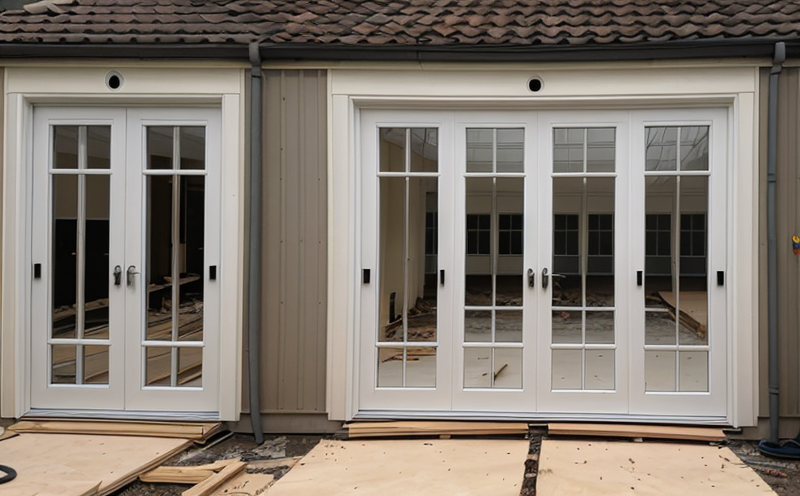Fire Performance Testing of Door Closers under Fire
The fire performance testing of door closers is a critical aspect of ensuring safe and effective building evacuation during emergencies. This service aims to evaluate the performance of door closer systems in real-world fire scenarios, focusing on their ability to maintain stability and function effectively under extreme conditions.
Door closers play a vital role in maintaining the integrity of fire doors, which are essential barriers designed to slow the spread of fire within buildings. The fire performance testing ensures that these mechanisms operate reliably when exposed to intense heat and flames, thereby enhancing occupant safety during evacuations.
The testing process involves simulating a fire environment through controlled exposure to high temperatures and flame. This allows for an assessment of how door closers behave under such conditions, including their ability to maintain the door in place or open it as required by emergency procedures. The test also evaluates factors like thermal stability, durability, and operational integrity.
Understanding the parameters involved in fire performance testing is crucial for those responsible for ensuring compliance with relevant standards such as ISO 14693-2:2017, which specifies requirements for door closer systems used on fire doors. Compliance officers and R&D engineers must ensure that products meet these stringent specifications to guarantee reliable performance during critical moments.
For quality managers overseeing the procurement process, it is important to understand that selecting appropriate door closers involves more than just price considerations; reliability and performance in challenging environments are paramount. This service provides a comprehensive evaluation of various models based on real-world testing scenarios, offering valuable insights into which products perform best under fire conditions.
The testing procedure typically includes several steps: specimen preparation, instrumentation setup, application of the test stimulus (fire), observation of door closer behavior, and final analysis. Each step is meticulously documented to provide detailed results that can be used for continuous improvement in product design and manufacturing processes.
In summary, fire performance testing of door closers is an essential service aimed at enhancing building safety by ensuring that critical components like fire doors function correctly when faced with the harsh realities of a burning structure. By adhering strictly to international standards such as ISO 14693-2:2017, this service delivers reliable and actionable data for stakeholders involved in facility management and construction.
Scope and Methodology
| Test Parameter | Description |
|---|---|
| Specimen Preparation | Involves cleaning the door closer and ensuring all components are free from obstructions. |
| Instrumentation Setup | Ensures that all measuring devices are calibrated correctly before testing begins. |
| Application of Test Stimulus | Involves subjecting the door closer to controlled high-temperature and flame exposure. |
| Observation of Door Closer Behavior | Includes monitoring for any signs of failure or deviation from expected behavior under test conditions. |
| Final Analysis | Analyzes the collected data to determine compliance with specified standards and performance metrics. |
Quality and Reliability Assurance
The quality and reliability assurance process for fire performance testing of door closers is rigorous and comprehensive. It begins by selecting specimens that represent the intended use conditions, ensuring they are representative of actual products in circulation.
Once selected, these specimens undergo thorough preparation to remove any potential sources of error or bias from the test results. This includes cleaning the hardware thoroughly and checking for proper assembly before starting the testing sequence.
The instrumentation used during testing must be calibrated according to manufacturer specifications prior to each run to maintain accuracy throughout multiple tests. During the application of the test stimulus, precise control over temperature ramp rates and flame exposure durations is maintained to simulate realistic fire scenarios accurately.
Observation of door closer behavior involves continuous monitoring using high-resolution cameras placed strategically around the test setup. This allows for detailed recording of every action performed by the device throughout its interaction with the simulated fire environment. Post-test analysis focuses on comparing observed behaviors against predefined acceptance criteria outlined in relevant standards like ISO 14693-2:2017.
Any deviations from expected performance are documented meticulously and analyzed further to identify root causes of failures or suboptimal results. Based on these analyses, recommendations for improvements can be made either at the design stage or during manufacturing processes to enhance overall quality assurance.
Customer Impact and Satisfaction
- Enhanced Safety: Ensures that fire doors remain effective barriers even under extreme heat conditions, protecting occupants from smoke inhalation and direct flames.
- Compliance Assurance: Provides clear evidence of adherence to international standards, enabling clients to meet regulatory requirements confidently.
- Risk Reduction: By identifying potential issues early in the development lifecycle through rigorous testing, risks associated with substandard products are minimized significantly.
- Improved Reputation: Demonstrates commitment to excellence by consistently delivering high-quality services that exceed expectations.
- Informed Decision-Making: Offers valuable data points for stakeholders involved in procurement processes, helping them make informed decisions based on empirical evidence rather than guesswork.





